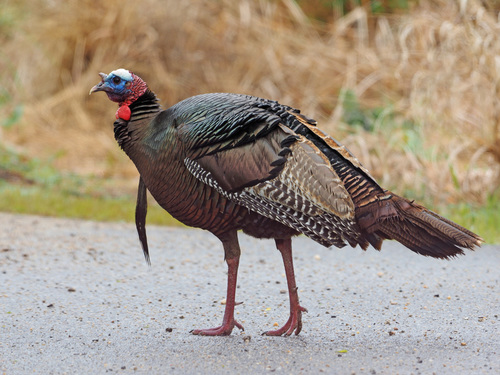
Wild Turkey
The Wild Turkey (Meleagris gallopavo) is a large, ground-dwelling bird native to North America. It is one of only two species of turkey, the other being the Ocellated Turkey found in Central America. Wild Turkeys play a significant role in their ecosystems as both predator and prey, consuming insects, seeds, and nuts, while also serving as a food source for larger predators. Historically, the Wild Turkey held cultural significance for Native American tribes, and it remains an important game bird today, symbolizing both wilderness and a connection to the natural world. Its successful recovery from near extinction in the 20th century is a major conservation success story.
76-125 cm
Length
125-144 cm
Wingspan
Least Concern
Conservation Status
Distribution
Wild Turkeys are native to North America, ranging from southern Canada through the United States and into Mexico. They have also been introduced to other parts of the world, including some areas of Europe and New Zealand. Within their range, they exhibit considerable adaptability to different elevations.
Lifespan
3-5 years in the wild; up to 10 years in captivity.
Wild Turkey's Habitat
Habitat Types
Mixed forests, Woodlands, Grasslands, Swamps, Agricultural fields
Climate Zones
Temperate, Subtropical
Adaptations
Wild Turkeys have strong legs for walking and running, allowing them to forage efficiently on the ground. Their broad wings enable short bursts of powerful flight, primarily used to escape predators or roost in trees at night. They possess keen eyesight and hearing.
Variations
There are several recognized subspecies of Wild Turkey, including the Eastern, Osceola, Rio Grande, Merriam's, and Gould's. These subspecies exhibit variations in plumage coloration, size, and habitat preferences.
Appearance
Breeding Plumage
Breeding males exhibit more iridescent bronze and green plumage, with prominent displays of tail feathers. Non-breeding males and females have duller coloration.
Seasonal Feather Changes
Plumage is generally darker in the winter and more bronze-colored in the breeding season.
Sex Based Plumage Differences
Males have darker, more iridescent plumage overall, with a prominent 'beard' of modified feathers on the chest, and spurs on their legs. Females are smaller and duller brown or gray.
Notable Features
Snood (a fleshy protuberance on the forehead), Caruncles (fleshy growths on the head and neck), Beard (a tuft of hair-like feathers on the chest, more prominent in males), Spurs (sharp projections on the legs, used for fighting, larger in males)
Diet and Feeding
Primary Foods
Seeds, Nuts (acorns, beechnuts), Berries, Insects, Small invertebrates, Plant matter (leaves, buds)
Foraging Behavior
Wild Turkeys primarily forage on the ground, scratching with their feet to uncover food. They also glean food from plants and occasionally fly up to reach berries or fruits.
Specializations
Their strong gizzard helps them grind and digest hard seeds and nuts.
Seasonal Diet Variations
Diet varies seasonally. In spring and summer, they consume more insects and soft plant matter. In fall and winter, they rely more on seeds, nuts, and grains.
Behavior
Social Structure
Wild Turkeys are social birds, often forming flocks, especially outside of the breeding season. Hens and their young form separate flocks from mature males.
Communication
Gobbling (primarily by males), Clucking, Purring, Yelping, Visual displays (strutting, tail fanning)
Migration
Most Wild Turkey populations are non-migratory, but some may make short-distance movements in response to food availability or severe weather.
Territorial or Group Behaviors
During the breeding season, males establish dominance hierarchies and may defend territories. Outside of breeding, they form loose flocks.
Conservation
Threats
Habitat loss and fragmentation, Historical overhunting (now largely regulated), Disease (e.g., avian pox, lymphoproliferative disease)
Protection Programs
Habitat restoration and management, Regulated hunting seasons, Research and monitoring programs, Reintroduction programs (successful in many areas)
Local National Laws
Protected under various state and federal wildlife laws in the United States and Canada.
Population Trend
Increasing
Population Estimates
Estimated at around 6-7 million in North America.
Interesting Facts
Wild Turkeys can run at speeds up to 25 mph.
This helps them evade predators on the ground.
They can fly at speeds up to 55 mph for short distances.
Although they primarily walk, flight is important for roosting and escaping danger.
Benjamin Franklin advocated for the Wild Turkey to be the national bird of the United States, rather than the Bald Eagle.
He considered the turkey a more respectable bird.
Wild turkey poults are precocial.
This means that they are relatively mature and mobile from the moment of hatching.
Faqs about Wild Turkey
What is the difference between a wild turkey and a domestic turkey?
Wild Turkeys are leaner, have darker meat, and are capable of flight, unlike most domesticated turkeys, which have been bred for larger size and white meat.
Are Wild Turkeys dangerous?
Wild Turkeys are generally not aggressive towards humans, but they can become defensive if they feel threatened, especially during the breeding season or when protecting young. It's best to observe them from a distance.
Why do male turkeys have beards?
The beard is a tuft of modified feathers, and its function is not entirely understood. It may play a role in mate selection, with longer beards potentially indicating a healthier or more dominant male.
Do Wild Turkeys migrate?
Most populations are non-migratory, but some may shift their range locally in response to food availability or severe weather conditions.
Copyright @ Nature Style Limited. All Rights Reserved.
 English
English